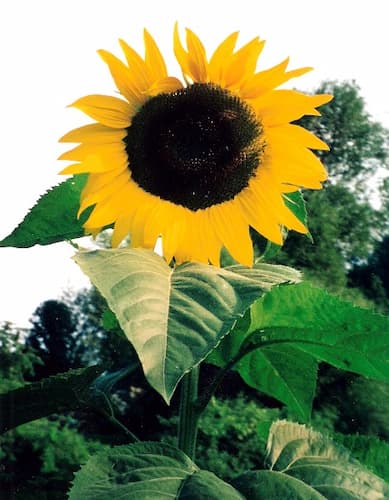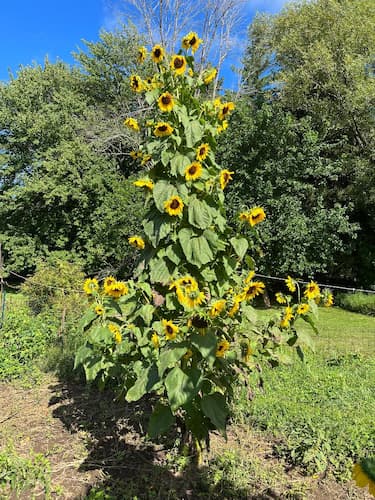How to Grow Giant Sunflowers

Growing Giant Sunflowers in Your Yard or Garden
Are you ready to grow a world record giant sunflower? If you currently grow sunflowers, you already know that there are sunflower plants, and then there are Giant Sunflower plants. At some point, most sunflower growers try their hand at growing giant sunflowers. Many of them, including this author, get hooked on growing giant sunflowers. There is a fascination with growing the tallest sunflower. There’s an equal fascination at growing the biggest, most gi-gundous sunflower bloom, or head.
If you have ever been to a county fair, state fair, or 4-H club competition, chances are you’ve seen giant sunflowers. Fall giant pumpkin weigh-offs often include a competition category for giant sunflowers, complete with monetary prizes for the tallest sunflower, and/or the biggest flowerhead.
Just how big can a sunflower grow? Well, scroll down to the “World Record Sunflowers” below!
Tip: Genetics plays an important role in growing these huge sunflowers. We recommend you go to a fall competition for them. Get to know the growers. And, with a little luck, maybe they will give you a couple of world record giant sunflower seeds. Now, you’re ready to break the world record next year!
Varieties of Giant Sunflowers
There number of varieties of giant sunflowers. Here are a few of them:
Mammoth – Perhaps the best known of the giant sunflower varieties. Many believe it is also the best looking. An enormous head, more than a foot across, sits atop a 7-12 foot plant. The big seeds are great for roasting, too.
American Giant Hybrid – If you are looking for the tallest plant, this variety produces very tall plants. However, the head is not as big. The plant grows up to 16 feet. Blooms are approximately 10 inches in diameter.
Skyscraper – Grows a very big flowerhead of 14 inches across or more. The plant grows about 12 feet .

World Record Giant Sunflowers
Yup, they grow sunflowers pretty darn big. If you are out to beak the world record, here is what you have to beat:
Tallest Sunflower: 25 ft. 5 1/2 inches tall, grown by M Heijms in Oirschot, the Netherlands in 1986.
Largest Flowerhead: 32 1/4 inches in diameter, It was grown by Emily Martin in Maple Ridge, British Columbia, Canada in 1983.
Most Flowers on a Single Plant: 837 flowers! Grown by Melvin Hemker in Saint Charles, Mi. in 2001.
Note: The flowerhead diameter is measured from the outer tip of the petal on one side to the outer tip of the petal on the opposite side.
Plant Propagation
Giant sunflowers are grown from seed. You can start them outdoors. Directly sow giant sunflower seeds into the garden after all danger of frost has passed. Or, you can start giant sunflower seeds indoors in a large peat pot. However, if you start them indoors, do not let them get root-bound. Carefully transplant them into their summer home as soon as possible.
The final spacing of plants should be 2-3 feet apart. If you are growing them to get them as big as possible, we recommend a full three feet, so the plants do not shade each other.
Tip: Squirrels and birds seek out sunflower seeds. After planting, place a screen over them, to deter pests from digging up the seeds.
How to Grow Giant Sunflower Plants
Giant Sunflowers need to be grown in full sun. Soil conditions can vary, from average to rich soil. To produce optimum growth, the soil should be very rich. The richer the soil, the better the plant growth. The soil should also be well-drained. Dig a hole two to three feet deep. Fill it with layers of compost, regular garden soil, and manure. This will help to promote optimum plant growth.
One of the important ingredients to fueling giant growth is a regular supply of fertilizer. Begin your fertilizer regimen with a high nitrogen formula. If you are growing sunflowers for record height, continue the high nitrogen formula all season long. For big blooms, switch to a high phosphorous formula, as the plant nears its expected height and the flowerhead begins to form.
Give your plants a regular supply of water. Deeply water your plants, to assure it gets to all of the roots. Do not allow the soil to dry out. And, do not soak the soil.
Staking giant sunflower plants is very important. These tall, heavy plants are susceptible to falling over on windy days. The stake doesn’t have to be as tall as the plant. But, it should be several feet tall and anchored firmly into the ground.
Harvest sunflower seeds after the bloom has died. Check a seed or two. Squeeze it to see if it is hard and full. If it is hollow or soft, it is not ready. The trick is to get them when they are mature, and before the birds get to the seeds.
Days to Maturity: 75 to 90 days, or more
Ideal Soil pH: 6.5 – 7.5.
Also, see:
Plant Problems – Identify the causes and find the cures.
Insects and Plant Disease
Giant Sunflowers experience few insect and disease problems.
Ants may be frequent travelers up and down the stalk. They usually do not do any serious damage to the plant.
Plant Pests
Like you, Birds eagerly await the ripening sunflower seeds. They will beat you to them if you let them. Of course, you might be like me, and grow sunflowers to feed and watch the birds.
Squirrels love sunflower seeds. You may find them hanging from the stalk, feeding upon the seeds.
Deer and rabbits will chew on small plants, especially the growing tip. Protect against these pests.
Related Articles
Also, people who read this article will like:
Sunflower Images – see our picture gallery
Giant Vegetable Seeds – Get the right genetics, to grow a variety of giant vegetables.
Please support our site. Shop for:
- rmmatthews100@hotmail.com
- 585-721-6528
- Rochester, NY
©1999-2024 GardenersNet.Com, All Rights Reserved

